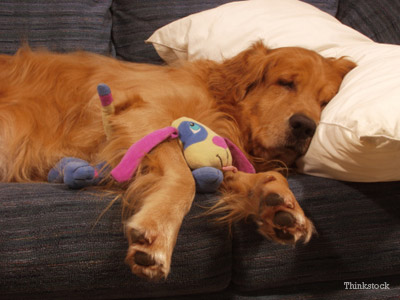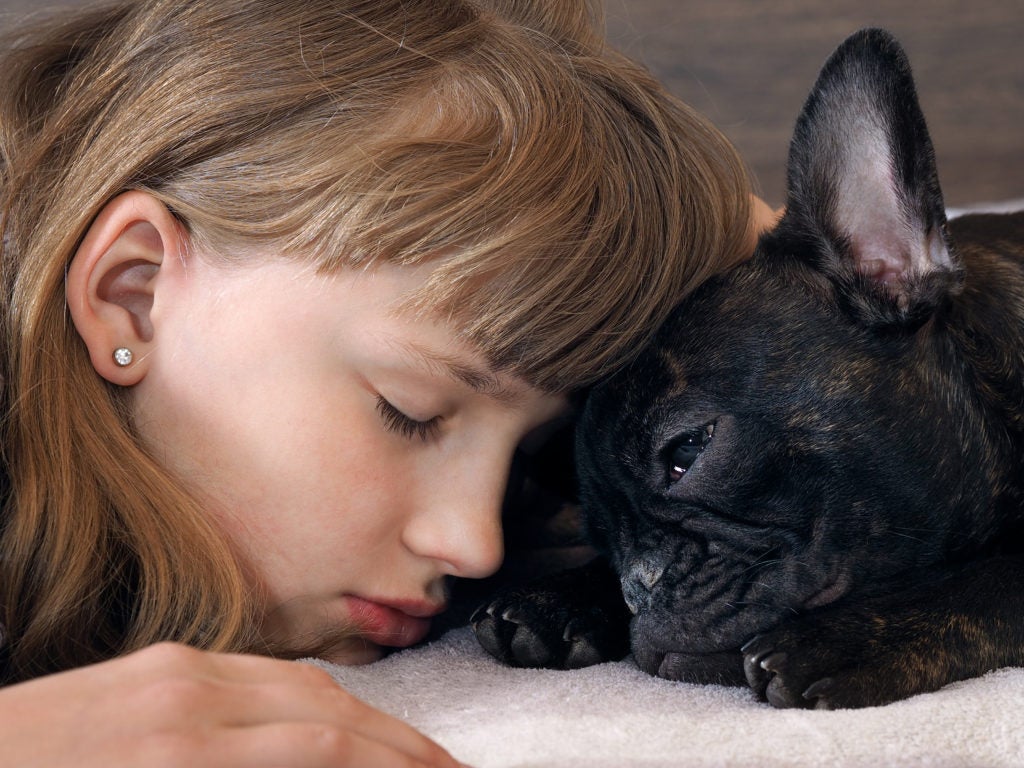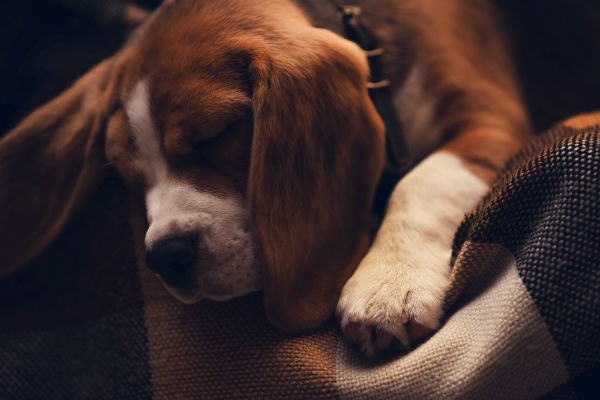Do Dogs Dream?

Whether or not dogs dream isn’t known with scientific certainty, but it sure is difficult to imagine that they don’t. We’ve all watched our dogs demonstrate behaviors in their sleep that resemble what they do in a fully awake state. Paddling legs, whining, growling, wagging tails, chewing jowls, and twitching noses inspire us to wonder what our dogs are dreaming about.
What we know about dogs and dreams
While our knowledge on this topic is very limited, the following known information helps us believe that dogs do indeed experience dreams. According to MIT News, Matthew Wilson, a professor of neuroscience at MIT, and Kenway Louie, a graduate student in 2001, have studied the relationships between memory, sleep, and dreams. They found that when rats were trained to run along a circular track for food rewards, their brains created a distinctive firing pattern of neurons (brain cells). The researchers repeated the brain monitoring while the rats were sleeping. Low and behold, they observed the same signature brain activity pattern associated with running whether the rats were awake or asleep. In fact, the memories played at approximately the same speed during sleep as when the rats were awake.
Can we apply this to dogs?
Can we take what is known about dreaming in rats and humans and apply the information to dogs? Wilson believes that we can."My guess is — unless there is something special about rats and humans — that cats and dogs are doing exactly the same thing," he said, according to USA Today’s website.
It is known that the hippocampus, the portion of the brain that collects and stores memories, is wired much the same way in all mammals. According to healthday.com, Professor Wilson says, “If you compared a hippocampus in a rat to a dog; in a cat to a human, they contain all of the same pieces.” He believes that as dogs sleep, images of past events replay in their minds, much the same way people recall experiences while dreaming.
In people, it is known that most dreams occur during REM (rapid eye movement) sleep, according to the National Institutes of Health. Dogs also experience periods of REM sleep. Psychology Today’s website says that during REM their breathing becomes more irregular and shallow. There may be muscle twitching during REM and, when one looks closely, rapid eye movements behind closed eyelids can often be observed. It is during REM sleep that behaviors thought to be associated with dreaming (legs paddling, twitching, vocalizing, etc.) are most commonly observed.
What we want to believe about dog dreams
When we observe our dogs as they sleep, it’s just about impossible to imagine that they are not dreaming. Just like the rats studied by Wilson and Louie, it is tempting to believe that our four-legged best buddies are reenacting their recent experiences; playing at the dog park, sniffing in the woods, chewing on a treasured bone, and chasing squirrels.
The National Institutes of Health says that Sigmund Freud theorized that dreaming was a “safety valve” for our unconscious desires. Perhaps he is correct, and, when our dogs sleep, they dream about catching the neighbor’s pesky cat, continuous belly rubs in conjunction with unlimited dog treats, and stealing the Thanksgiving turkey from the dining room table.
If you have any questions or concerns, you should always visit or call your veterinarian -- they are your best resource to ensure the health and well-being of your pets.
What we know about dogs and dreams
While our knowledge on this topic is very limited, the following known information helps us believe that dogs do indeed experience dreams. According to MIT News, Matthew Wilson, a professor of neuroscience at MIT, and Kenway Louie, a graduate student in 2001, have studied the relationships between memory, sleep, and dreams. They found that when rats were trained to run along a circular track for food rewards, their brains created a distinctive firing pattern of neurons (brain cells). The researchers repeated the brain monitoring while the rats were sleeping. Low and behold, they observed the same signature brain activity pattern associated with running whether the rats were awake or asleep. In fact, the memories played at approximately the same speed during sleep as when the rats were awake.
What Do Dogs Dream About?

What do dogs dream about? Have you ever wondered? Is she really hunting rabbits, or is she just twitching in her sleep? Do dogs dream as we do?
While we don’t have all of the answers, scientists are taking steps to figure out dog dreams, bringing us one step closer to understanding our canine companions.
Do Dogs Dream?
Humans don’t have a monopoly on dreams. In fact, scientists believe that most vertebrates, and maybe even the humble fruit fly, can – and do – dream on a regular basis.
Like us, dogs and other animals go through several sleep cycles. There are periods of wakefulness, followed by Rapid Eye Movement (REM) sleep, and non-rapid-eye-movement sleep. REM sleep is the period responsible for the most memorable and vivid dreams and is believed to be a part of how the body processes memory, among other things. Scientists can track these cycles and associated brain activity using specialized equipment.
One of the most famous of these dream experiments involved lab rats. These rats spent all day running in a maze. Scientists monitored the brain activity of the rats in the maze and compared it to the brain activity of the rats during REM sleep. What they found was that the same areas lit up in the rats’ brains, which meant that the rats were likely to be dreaming of the maze, and by comparing the data the researchers could figure out where exactly in the maze the rats had dreamed themselves.
This suggested to the researchers that animals tend to dream as we do. The rats dreamed about their day, just like you might find yourself back in the office in your dreams, even if you would rather have dreamed yourself someplace more exciting. Researchers at MIT concluded that animals have complex dreams, and they can remember and replay long sequences of events when they are asleep.
The National Sleep Foundation reports that dogs spend about half their day sleeping. For puppies, senior dogs, and larger breeds, time spent sleeping can be even longer.

What Do Dogs Dream About?
Most dogs lead more interesting lives than rats. To figure out what dogs might dream of, researchers performed a test that temporarily disabled the pons.
If, like me, you’d never heard of the pons before this, let me explain. The pons is the part of the brain stem that is involved in the control of sleep cycles and the regulation of deep sleep and is responsible for inhibiting your large muscles from moving during sleep. In other words, you can thank the pons for preventing your partner from flailing around during dreams and waking you up. Without the pons, we might act out everything we were dreaming about — probably with disastrous results.
You may have noticed that puppies and older dogs twitch and move a lot in their sleep. This is because the pons is underdeveloped in puppies and less efficient in older dogs, according to Stanley Coren, a professor emeritus of psychology at the University of British Columbia. The same is true for human infants and older adults.
Researchers figured out that one of the ways to discover what dogs might dream about is to temporarily disable the pons during REM sleep. This allowed them, under carefully controlled conditions, to let the dogs act out their dreams.
The results were pretty much what we’ve all suspected for years.
“What we’ve basically found is that dogs dream doggy things . . . The dream pattern in dogs seems to be very similar to the dream pattern in humans,” according to the researchers.
Does the Dog’s Breed Affect Dreams?
People vary as to how often they dream and what they dream about, and researchers believe that is true of dogs, as well. Coren reports that small dogs have more frequent dreams than large dogs, but those small dog dreams are shorter in duration. Large dogs, on the other hand, have fewer, but longer dreams.
We can also hazard a guess that what your dog does all day determines his dreams. While we can’t yet be sure, the fact that Pointers point and Dobermans display guard behavior implies that breed-specific activities may take place during dreams, too. Your Labrador Retriever, for instance, is more likely to dream about chasing tennis balls than is a Pug.
Do Dogs Have Nightmares?
Not all human dreams are good. We infer that dogs can have nightmares, too. These nightmares are hard to watch. It can be tempting to wake your dog to comfort her, as you would a child, but there are some risks associated with doggy nightmares that you should share with your family.
If you’ve ever been woken from a scary dream, you know that it can take a minute to remember where you are and whom you are with. Like some people, dogs can react aggressively toward the person waking them. This can be dangerous, especially for children. The best thing that you can do for a dog you think is having a bad dream is to wait for your dog to wake up and be there to comfort him, following the old saying “let sleeping dogs lie.”

What Is My Dog Dreaming About?
There is no way for us to know exactly what makes up the stuff of our dogs’ dreams, but we might be able to guess.
Observe your dog during sleep to see what he does. REM sleep typically begins 20 minutes into a nap and lasts for two-to-three minutes. This is when you might notice your dog twitching or making sounds. Are there any similarities between your dog’s actions during REM sleep and his daily activities?
My dog, for instance, does a lot of running in her sleep. Her paws are always twitching, and her lips move. Is she chasing something? Playing with a doggy friend? Chasing an intruder? Or simply running down her tennis ball in a big, open field? I don’t know the details, but since these are her favorite things to do while awake, I am pretty sure she dreams about them.
Sometimes, our dogs give us even more clues. In an interview with a Harvard psychologist, one owner reported that he suspected his dog had recently had a nightmare about bath time. This dog did not like baths, and when the bath was over, he always ran to the owner and hid between his legs. He did not perform this behavior any other time. One day, the owner observed his dog having a dream. When the dog woke up, it bolted and hid between his legs, leading the owner to conclude that the dog had just had a scary dream about his bath.
No matter what our dogs dream about, there is some comfort in believing that they, like us, have dreams and fears that play out in their sleep, making us more alike than different.

No comments:
Post a Comment